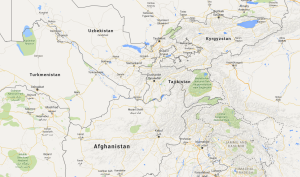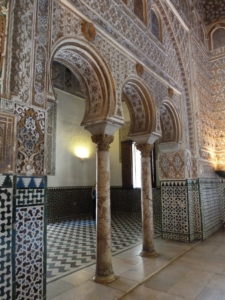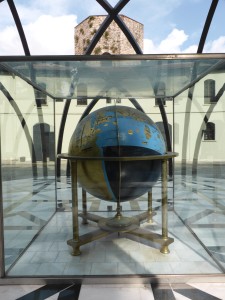Today’s book review is a bit different for this blog – the book is a fairly dense history of a part of the world that doesn’t get much attention these days. It is Lost Enlightenment: Central Asia’s Golden Age from the Arab Conquest to Tamerlane, by S Frederick Starr.

I bought this book after becoming fascinated by the mathematical and scientific discoveries made by Arab thinkers. Istanbul has a Museum of the History of Science and Technology in Islam. Growing up in Australia, all my knowledge of the history of science was of Europe – especially the mathematicians and physicists of the Renaissance, starting with Fibonacci around 1200. But of course Fibonacci is primarily famous for popularising the Hindu-Arabic system in Europe (as well as the Fibonacci number). The mathematicians who actually invented and studied that system were further east. I had thought that further east was the Arab Islamic world centring around Iraq. But this book makes a persuasive case for a golden age even further east – in places that these days are mostly only in the news because of terrorism or opium dealing.
The centre was a city called Balkh (or Bactria) in Northern Afghanistan.
Among the many mathematical and scientific innovators from the area were:
- Ahmad Musa (from Merv, Turkmenistan) created a Book of Ingenious Devices in around 820, in Baghdad, which includes a mechanical flute, driven by steam, which has been hailed by some as the first programmable machine
- Khwarazami (750-850) came from what is now Uzbekistan. He built his intellectual life in Merv, Turkmenistan, but then moved to Baghdad with the caliphate.
He systematized and named algebra, opened the field of spherical trigonometry and was also the key advocate for persuading Arabs and then Europeans to adopt the Hindu decimal system of numbers and its innovative concept of zero.
Khwarazmi’s great achievement was to have brought algebra into its own, creating a unifying theory which allowed rational numbers, irrational numbers, geometrical magnitudes, etc, all to be treated as ‘algebraic objects’.
His Book of the Map of the world became the cornerstone of all subsequent geographical studies in Arabic or Western languages
- Ibn Sina (born in 980), from Bukhara, Uzbekistan, (known in the west as Avicenna) wrote the Canon of Medicine – a mediaeval encyclopedia of medicine which was still in use in 1650. But although the Canon (with its very modern suggestions on using alcohol as an antiseptic, and the boiling of water to prevent the spread of disease) is what he is known for, he wrote hundreds of books on science and philosophy, including a systematic textbook on opthalmology.
- Abu Biruni, from Guranj, also in Uzbekistan, exchanged letters with Ibn Sina on whether planetary orbits could be elliptical. He didn’t come up with the idea that the sun was at the centre of the orbits (rather than the earth), but he did argue that there must be other worlds out there, five hundred years before Giordano Bruno was born (who was burned at he stake for the same idea). And just in case science wasn’t enough, he put together the first global calendar system and chronology of all the human history he knew about. After he’d used his detailed observations of the planet (in which he measured one degree of longitude to within a kilometre) he pointed out that two-thirds of the world was unknown, and suggested there was probably an inhabited landmass between Asia and Europe
 So there were a whole lot of interesting thinkers in areas that we now think of as some of the poorest and most backward places on the planet. But why have we never heard of them (or if we have, do we vaguely think that they came from some middle eastern country)? And why didn’t their development continue?
So there were a whole lot of interesting thinkers in areas that we now think of as some of the poorest and most backward places on the planet. But why have we never heard of them (or if we have, do we vaguely think that they came from some middle eastern country)? And why didn’t their development continue?
The central asian enlightenment was characterised by abundant respect for scientists and philosophers. Most rulers had a number of court scientists. These scientists were not just thinkers; they were often engineers, or bureaucrats, a court of scientists being seen as q requirement for being an important ruler. Central Asia was also a region of literacy. While paper was invented in China, central asia dramatically improved the product by making it out of cotton. While printing hadn’t been invented yet, the wide availability of paper meant that literacy and information were widespread.
So what happened to change that? Sadly the answer is probably quite relevant to the modern-day. While there are a number of possible explanations for the decline of science and mathematics in central asia (including climate change in the very arid areas, the Mongol conquests in the early 1200s, led by Ghengis Khan, and a general fragmentation of political control and hence the availability of patronage), Starr comes down on the side of a change in the interaction between religion and the rest of society.
 In around 1100, the predominant interpretation of Islam, the main religion, changed fundamentally – moving towards Sufi mysticism. The most prominent thinker to legitimize Sufism within Islam was one of the most renowned Islamic philosophers – Abu Hamid Muhammad al-Ghazali (1058-1111):
In around 1100, the predominant interpretation of Islam, the main religion, changed fundamentally – moving towards Sufi mysticism. The most prominent thinker to legitimize Sufism within Islam was one of the most renowned Islamic philosophers – Abu Hamid Muhammad al-Ghazali (1058-1111):
Ghazali argued that science itself bred a kind of rationalism that leads to skepticism and atheism. Neither reason nor logic was relevant to the real purpose of humankind, and the entire scientific and philosophic quest – indeed the very idea of a society committed to the pursuit of new knowledge – struck Ghazali as nothing but a hollow delusion.
Fifty years after Ghazali’s own death in 1111, the champions of free and uninhibited inquiry were in full retreat, under withering attack from a new orthodox mainstream whose dogmatic partisans marched under Ghazali’s banner.
Starr’s conclusion is that the move towards Sufism, which was catalysed by Ghazali’s prominence as an anti-scientific thinker, was the main cause of the retreat from science and enlightenment.
Ghazali’s youthful denunciation of science and philosophy had become a best-seller with the Arabic-reading public. Never again would open-ended scientific enquiry and unconstrained philosophizing take place in the Muslim world without the suspicion of heresy and apostasy lurking in the air.
As the range of open questions narrowed, the Arabic language, which had once been an instrument of connectivity and a powerful force for the dissemination of the latest inquiries, was constricted to a largely religious role.
While today’s society certainly seems far more open to scientific inquiry than that more closed, mystic approach to life that Ghazali advocated, we can learn from the Central Asian experience nonetheless. For five centuries, the Central Asian region was the most sophisticated scientific and intellectual region in the world. After five centuries, the locals could probably be forgiven for thinking that that was the natural order of things. But gradually, scientists became less important than artists and mystics; society stopped seeing the value of the pursuit of new knowledge and scientific enquiry. And interpretations of the predominant religion became more important than conclusions arising from scientific method.
Our society today is far more open to scientific inquiry, and evidence based investigation. But the story of Central Asia is a cautionary tale that you cannot take it for granted. The oases cities of Merv and Balkh are now ruins in the desert. The thinking from those far off days lives on.
You can tell I found this history fascinating. The flourishing of human ingenuity, given the right conditions, is quite amazing, and it is everywhere, if you start looking.

Sounds awesome, thanks!
I read “Against the Gods” when started working for Swiss Re, which aso traces the history of the insurance industry to modern times. Sounds like this book goes much deeper into the origins of the foundational concepts and thus, a perfect complement – thanks! 🙂